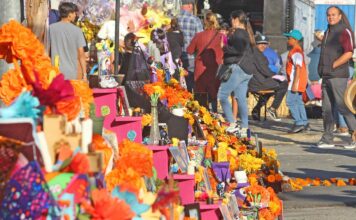New bridge over Uvas Creek will require a significant but brief
‘gap’ in the Deodora cedars lining Hecker Pass Highway, according
to study
Gilroy – Residents who have grown to love the scenic drive toward the Santa Cruz Ridgeline may soon have a brief but noticeable change in their experience, according to newly released state plans for a bridge relocation.
A long line of majestic cedars has filled the southern roadside vista along Hecker Pass Highway, the city’s tree-lined western gateway, for nearly a century. But, that view will be broken – if only for seconds – under one of two alternative state plans to relocate the deteriorating Uvas Creek bridge.
“Although of short duration, lasting less than five seconds at the posted speed limit, the noticeable gap in the dense … 60-plus-foot Deodara Cedar tree row would be initially quite apparent to both eastbound and westbound Route 152 travelers, particularly those familiar with current conditions,” according to newly issued environmental report by Caltrans, the state transportation agency. “This gap would become less noticeable over time.”
Relocating the bridge to the south would mean an accompanying shift and widening of Hecker Pass as it approaches the bridge on both sides. The plan would mean the loss of 15 historic Deodara cedar trees.
An alternative plan to move the bridge north would spare the southern Deodara, the report states, but would mean the loss of a greater overall number of trees and the installation of a 20-foot-high retaining wall, measuring the length of one and a half football fields.
The initial study, posted in recent days on the Caltrans Web site, recommends the agency adopt a “negative declaration” – government lingo meaning that officials do not believe the project will have a significant effect on the environment.
As part of its efforts to offset the loss of trees on either side, the agency proposes planting Blue Blossom or other shrubs or possibly new cedars, if the road’s expanded shoulder has enough room.
The report argues against the possibility of repairing or reconstructing the bridge in its current site due to higher costs, extended construction time and greater disruption of traffic. The relocation options would allow a seamless transition by keeping the current bridge open until the new one is complete, according to Jared Goldfine, a senior environmental planner for Caltrans.
The public has until Jan. 23 to comment on the agency’s proposal. If Caltrans ratifies the negative declaration after the public comment period, they could proceed without conducting a more-detailed Environmental Impact Report.
“As a lead agency we’ll always keep an open mind when presented with new information,” Goldfine said, “but we think we have two good alternatives.”
Local officials, residents and environmental activists remain hopeful that the agency, before signing off on either proposal, will give greater consideration to both the Deodara cedars and future plans for the Hecker Pass corridor.
City officials are working with landowners in the area on a road widening, roughly from the bridge to Santa Teresa Boulevard, to clear the way for hundreds of new homes atop hillsides and behind swaths of farmland. While a task force that crafted development guidelines for the area assumed the road could remain two lanes, other council members are not so sure.
Councilman Russ Valiquette believes the Uvas bridge plans should take account of the need to one day accommodate a four-lane highway.
“What can we do now so that we’re ready for when we do have to expand?” he asked. “Are we going to have to rip this bridge out? Build a new one next to it? Those are the kinds of questions I have for Caltrans.”
Carolyn Tognetti, an environmental advocate with Save Open Space Gilroy, hopes the agency will reconsider its plans entirely.
“I’m actually surprised (at the negative declaration) because when other developments go up near trees, they’re usually pretty adamant about trying to save them,” she said. “I think they do need to hear from the public, I’m hoping they’ll have a change of heart – and mind.”
Caltrans officials will meet with council members and planning commissioners Jan. 9 to discuss the project.
Goldfine said it would take two years to relocate the bridge. He predicted construction would start in 2009.













